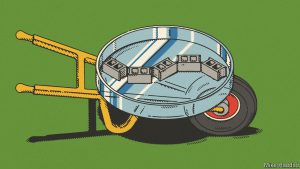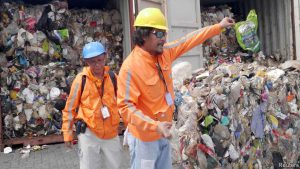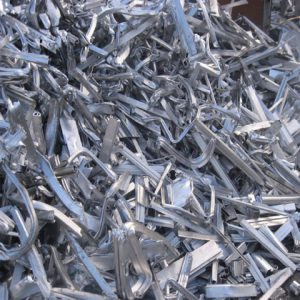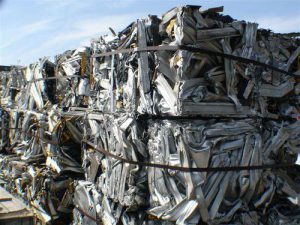By Yara Murray-Atfield
Posted Fri 27 Dec 2019 at 2:02am, updated Fri 27 Dec 2019 at 11:50am
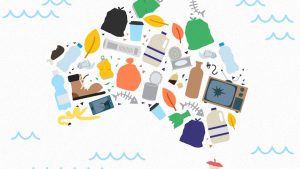
Do you know what happens to your rubbish once you’ve put it in the bin?(ABC News: Andrew Harrison)
Recycling has never been bigger news.
We have bag bans, single-use plastic bans, a local industry thrown into chaos by a decision in China, recycling companies making the headlines and even a war on waste.
And despite a huge national push to solve what’s been acknowledged as a recycling crisis, a lot of our waste is being sent straight to landfill or overseas.
Just how much waste are we talking about?
In short, it’s a lot.
The most up-to-date stats show Australians generated 67 million tonnes of waste in 2016-2017.
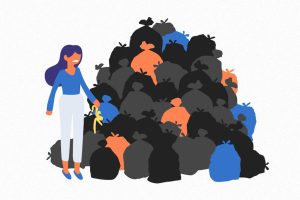
That’s 2.7 tonnes, per person, per year — roughly the weight of an African forest elephant.(ABC News: Andrew Harrison)
Of that, about 54 million tonnes is known as “core waste”, and is dealt with by the waste and resource recovery industry.
The rest is things like ash from electricity generation, mud from refining, manure from farming and liquid waste like sewage — stuff that can’t be picked up by a rubbish truck on bin day.
While a lot of the focus is on households, more than a third of our waste comes from the construction and demolition industry, and the same amount comes from the commercial and industrial sector.
Compared with other similar developed countries, the Department of Environment says we generate “more waste than the average” and recycle “a little less than the average”.
“We have way too much of a view that it’s just waste and you just throw it out,” says Gayle Sloan, the CEO of the Waste Management Association of Australia.
Where’s it all going?
Jenni Downes, a researcher at Monash University’s Sustainable Development Institute, says what happens once rubbish is put in a bin remains a mystery for many people.
She says a big part of that is the fact that waste companies have “designed their services to be almost invisible”.
“They’ve tried to make it as simple and convenient for householders so that you put your waste in the bin, and it disappears. Poof, it’s gone.”
For what goes into general waste bins the outcome is pretty simple — in most instances, it goes straight into landfill.
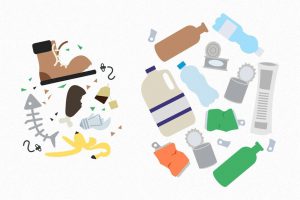
Of the 67 million tonnes of waste we created in 2016-2017, we recycled 37 million tonnes.(ABC News: Andrew Harrison)
A large portion of that — about 6.7 million tonnes — is organic waste like food and garden waste, which creates methane-rich greenhouse gases as it decomposes.
Only about 2 per cent of our waste is converted to energy, a much lower rate than some European countries.
And it’s estimated about 130,000 tonnes of Australian plastic ends up in waterways and oceans each year.
The three main ways it ends up there, according to WWF, are littering, products like wet wipes being flushed and plastic flying away from landfill processing.
What’s the recycling process like?
There are generally quite a few steps before recycling can be what the industry calls “manufacture ready”.
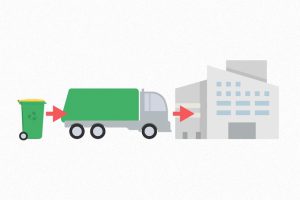
Kerbside recycling is first taken by a rubbish truck to a material recovery facility.(ABC News: Andrew Harrison)
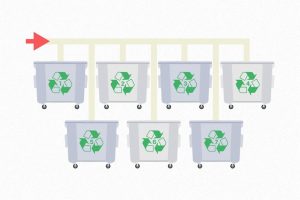
It’s then sorted into different streams, and often sorted again into sub-categories. With plastic, that’s where those little numbers on the packaging come in.(ABC News: Andrew Harrison)
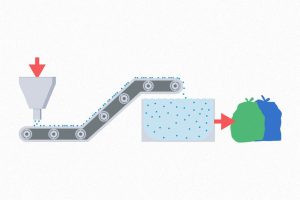
Plastic is then shredded, granulated, washed, dried, decontaminated and finally made into pellets that can be used in manufacturing.(ABC News: Andrew Harrison)
But Ms Sloan says a key part of the recycling process that’s often forgotten is buying products made from recycled materials.
“The loop is not closed unless you buy that back,” Ms Sloan says.
“You’re not recycling unless you’re buying recycled.”
So why does recycling get sent to landfill?
Where your recycling ends up really depends on what kind of material it is.
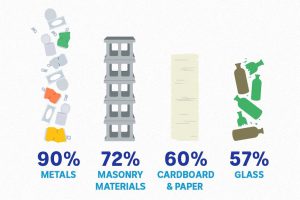
Most of Australia’s metal gets recycled, but other materials don’t have the same fate.(ABC News: Andrew Harrison)
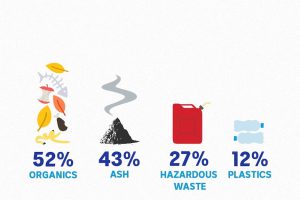
A large portion of our plastic is sent straight to landfill — often due to the way plastic creeps into so much packaging.(ABC News: Andrew Harrison)
Even once your recycling goes into the right bin, a lot of it is unusable due to contamination — broken glass, food, plastic bags, rubbish and liquids all increase the chance of the material being eventually sent to landfill.
“The difficulty is that over the past 20 years or so, our packaging has become much, much more sophisticated, and the types of materials and the way they’re put in have become way more complicated than when we first learnt to recycle,” Ms Downes says.
Things like plastic-lined paper, tissues and glassware often don’t make the cut.
The recycling company Visy calls this “wish-cycling” — where people hope materials can be recycled, but their presence actually dooms other perfectly good recyclables to landfill.
To combat this, Infrastructure Victoria has recommended a six-bin system so all the separating is done at home.
It’s more of a problem with kerbside recycling, as business and construction often get charged more if their waste isn’t up to scratch.
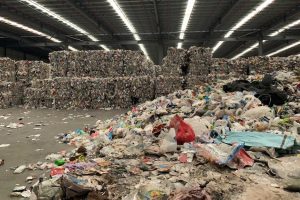
Lots of recyclable goods sit in warehouses or sorting facilities for a long time before they reach a final destination.(ABC News: James Oaten)
And even if it’s totally pristine, there’s no guarantee it’ll actually be recycled at the end of the process if there isn’t a buyer for it.
A 2017 Four Corners investigation found hundreds of thousands of tonnes of glass — which at the time was expensive to recycle — was sitting in New South Wales warehouses because there was “no viable market” for it.
In recent months, major Victorian company SKM Recycling went insolvent. While a number of councils and the State Government scrambled to find a solution, an estimated 780 rubbish trucks’ worth of recyclables were sent to landfill in a week.
What’s China got to do with it?
Until about two years ago, Chinese companies processed a lot of our recyclable material.
But that changed when the Government there brought in the National Sword Policy, which stopped the importation of 24 types of solid waste.
It meant thousands of tonnes of recyclables — and so thousands of dollars to be made from recycling companies — suddenly had nowhere to go.
“We’ve been having real troubles now because China has wanted it for so long, that all its competition in Australia has died out,” Ms Downes says.
The China decision immediately affected 1.3 million tonnes of Australian waste, which is about 4 per cent of Australia’s recyclable waste.
Despite the crackdown in China, we’re actually exporting slightly more waste overseas than we did before the waste ban began there — it’s increased by 5 per cent to reach 4.4 million tonnes.
But more and more countries, including India, Indonesia and Malaysia are following China’s lead and tightening restrictions.
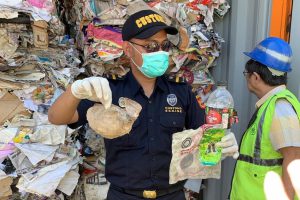
In some cases, the reason countries are cracking down is because of bad practices in Australia — like this nappy found in paper shipped to Indonesia.(ABC News: David Lipson)
What’s being done to deal with all that waste?
After months of talks, the Council of Australian Governments (COAG) has agreed to a near-total ban on exporting recyclables overseas, beginning in the second half of 2020.
Under the national waste policy action plan, which was hammered out in November and has seven targets, governments have agreed to set a timeline to ban the export of waste plastic, paper, glass and tyres.
It’s all part of the push for what’s known as the circular economy, where products and materials are continually used.
The plan aims to increase Australia’s resource recovery rate to 80 per cent — meaning the goal is for only 20 per cent to not be recycled.
As well as the slated export ban, the plan includes a goal of reducing the total waste generated in Australia by 10 per cent per person by 2030 — with the definition of “per person” still being worked out.
The action plan says it’ll have benefits for the economy as well. For every 10,000 tonnes of waste that is recycled, 9.2 jobs are created, compared to the 2.8 jobs if the same amount goes to landfill.
But advocates want the plan to go further.
“It’s really weak, and out of step with what other OECD nations are doing in the sense of it doesn’t have market demand,” Ms Sloan says.
But Ms Downes says not to get too disheartened by the current state of the recycling crisis.
“We’re getting closer to a solution that’s probably going to set us up for 30 or 40 years into the future,” Ms Downes says.
“This is a really big change. And change has road bumps, but we’re getting there.”
Posted 27 Dec 201927 Dec 2019, updated 27 Dec 2019
Link: abc.net.au/news/where-does-all-australias-waste-go/11755424
